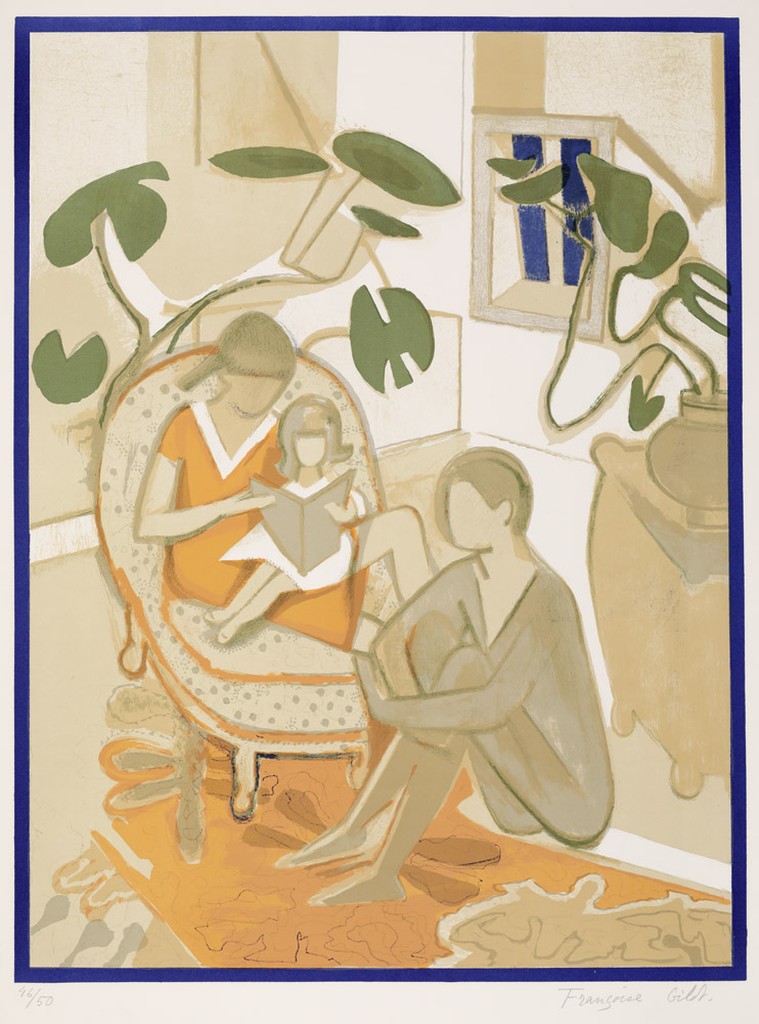
As an architecture student, when I’m often considering various designs or art I go with my gut. I always have an immediate internal reaction to whether I like a piece or not. Each of my classmates has their own reactions to designs, and I feel like our preferences reflect our varying personalities, backgrounds, and aspirations. This is how I chose which piece from Lehigh University Art Galleries to research; I went with my gut. My gut led me to a lovely lithograph by Françoise Gilot, called Les Enfants en Bretange, or Children in Brittany. The lithograph is printed on paper and is 26 x 19.75 inches. The first thing that caught my eye in this print was the organic and intertwining sage green plants that take up most of the upper third of the print. This then led my eye down to the mustard yellow dress and rug, where two adults are sitting. The woman is in a chair, reading with a young girl in her lap, and the man is crouched on the rug, listening to them read aloud. It is thought that the three figures in this piece are her three children. The sage green, mustard yellow, and muted beige tones of the print are balanced by a calm navy that framed the composition and acts as an accent color in the window.
Françoise Gilot was born in 1921, in Neuilly-sur-Seine, France. Her mother, Madeleine Gilot, was a watercolorist, who probably was an influence on Gilot because she declared that she would become a painter at just five years old. Her mother helped train her in her early years, and by the time Gilot was twenty-one, she was an accomplished in watercolor and ceramics. It was around this time that she started working with the Cubist painter, Pablo Picasso and they entered into a romantic relationship. It was from this long-term relationship that Gilot was exposed to Cubism and the process of printmaking. While she was influenced by the Cubist movement, she made the style her own by emphasizing organic shapes, not angular ones, exemplified in Les Enfants en Bretange. Gilot had two children with Picasso, Claude and Paloma, but her relationship with Picasso was not healthy. He was physically abusive, and had a legal wife, Olga Khovkhlova, who once assaulted Gilot in the street.
This particular print of Les Enfants en Bretange is number 46 out of 50 total. The project was commissioned in 1974 by a couple named Phillip and Muriel Berman. The Berman’s lived in Allentown, Pennsylvania. They were very active in the area, especially in their Jewish faith. The couple were personal friends with Gilot, from their years of traveling the world and collecting art. They commissioned Gilot to make Les Enfants en Bretange for Hadassah, a Women’s Zionist Jewish-Amercian Organization. Hadassah focuses on advocating for Women’s Rights (among other things) in the US, and the female educational theme of Les Enfants en Bretagne reflects the organization’s identity. When Phillip passed away in 1997, Muriel decided to donate Gilot’s print, among many other works of art and transcripts, to Lehigh University, their hometown institution.
Gilot leans to a more painterly form in her printmaking, possibly to pay homage to her training in watercolor. She once said “I am a painter who makes lithographs rather than a lithographer who paints and that is extremely different.” The background of Les Enfants en Bretagne does reflect a watercolor-esque quality. It has been said that Gilot’s printing process was very rapid, yet she still is successful in achieving a multi-dimensional space and color. Speaking to her process, Gilot said, “Begin with a non-figurative proposition and by the conjunction of visual signs, I lead myself (and the viewer as well) consequently toward a possible resolution, a reinvented paradise.”
Excellent research Brett, I didn’t know that the Bermans commissioned this piece (edition).